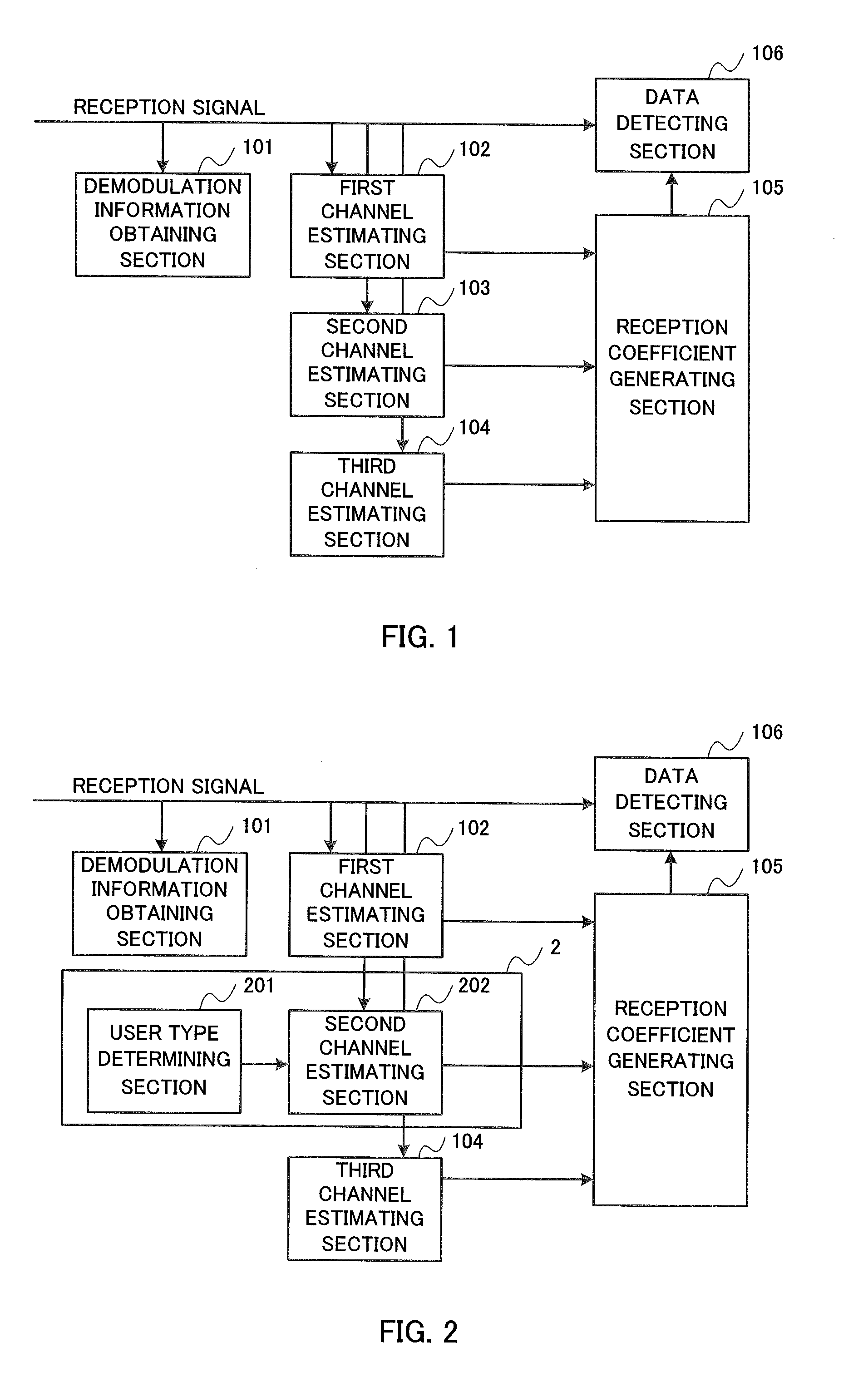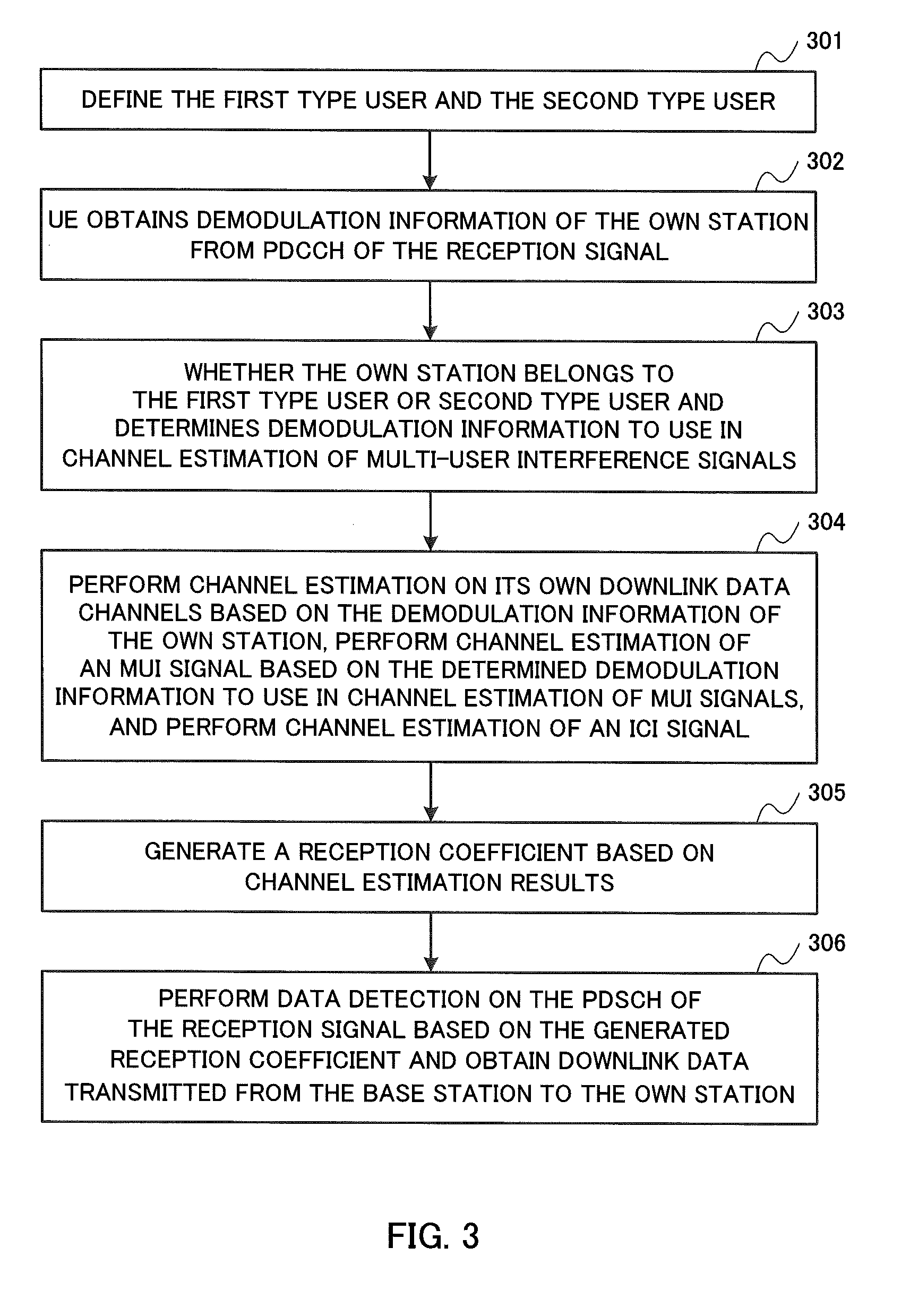Receiving apparatus, data receiving method, and channel estimating apparatus and method therefor
a data receiving and channel estimation technology, applied in the field of radio communication techniques, can solve the problems of inability to remove mui and perform accurate interference rejection of mui, so as to improve user and cell throughput, improve channel estimation accuracy, and improve the performance of data reception
- Summary
- Abstract
- Description
- Claims
- Application Information
AI Technical Summary
Benefits of technology
Problems solved by technology
Method used
Image
Examples
embodiment 1
[0047]In the embodiment 1, the UE apparatus determines whether the own station belongs to the first type user or the second type user based on the geographic position of the own station. More specifically, the above-mentioned geographic position is any one or any combination of parameters such as a distance between the UE apparatus and its serving base station, a path loss from the serving base station to the UE apparatus, the influence of shadow fading and neighbor cell interference. For example, when the distance between the own station and the serving base station is equal to or less than a predetermined threshold (close to the serving base station), it determines that the own station belongs to the first type user, and when the distance between the own station and the serving base station is greater than the predetermined threshold (far away from the serving base station), it determines that the own station belongs to the second type user. Or, when the path loss from the serving...
embodiment 2
[0062]In the second embodiment 2, the UE apparatus determines whether the own station belongs to the first type user or the second type user based on the demodulation information of the own station. As described above, the demodulation information includes a DM-RS port ID and an SCID. When the base station assigns DM-RS ports and SCIDs to UE apparatuses in ascending order, DM-RS port IDs and SCIDs which are smaller than the DM-RS port ID and / or SCID values can be only assigned to other UE apparatuses. In this case, as illustrated in FIG. 5, the inner structure of the above-mentioned receiving apparatus mainly has the following.
[0063]A demodulation information obtaining section 101 extracts demodulation information of the own station such as a DM-RS port ID and an SCID of the own station from the PDCCH of the reception signal.
[0064]A user type determining section 201 has a second user type determining module 2014 and a second demodulation information determining module 2015.
[0065]Not...
embodiment 3
[0082]The embodiment 3 is a combination of the method according to the embodiment 1 and the method according to the embodiment 2. In the embodiment 3, the UE apparatus determines whether the own station belongs to the first type user or the second type user based on the demodulation information of the own station and the geographic position of the own station.
[0083]For example, first, the method according to the embodiment 1 is used to determine whether or not the own station is a user far away from a corresponding serving base station (a RSRP / RSRQ difference is small, that is, a signal to noise radio is poor). When it is determined that the own station is a user far away from the serving base station, it determines that it is not necessary for the own station to perform channel estimation of multi-user interference, that is, it recognizes the own station as a SU-MIMO user. When it is determined that the own station is a user close to the serving base station (the RSRP / RSRQ differen...
PUM
 Login to View More
Login to View More Abstract
Description
Claims
Application Information
 Login to View More
Login to View More - R&D
- Intellectual Property
- Life Sciences
- Materials
- Tech Scout
- Unparalleled Data Quality
- Higher Quality Content
- 60% Fewer Hallucinations
Browse by: Latest US Patents, China's latest patents, Technical Efficacy Thesaurus, Application Domain, Technology Topic, Popular Technical Reports.
© 2025 PatSnap. All rights reserved.Legal|Privacy policy|Modern Slavery Act Transparency Statement|Sitemap|About US| Contact US: help@patsnap.com



